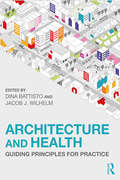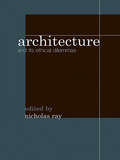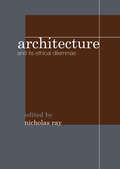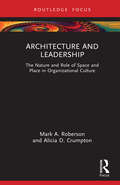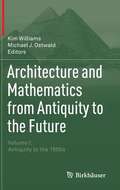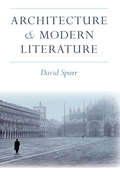- Table View
- List View
Architecture and Globalisation in the Persian Gulf Region
by Nasser GolzariThis is the first book ever to examine the architecture and urbanism of the Persian Gulf as a complete entity, dealing equally with conditions on the eastern Iranian shoreline as in Arabic countries on the western side. By inviting a range of architects and scholars to write about historical and contemporary influences on 14 cities along both Gulf coastlines, the book traces the changes in architecture and human settlement in relation to environmental factors and particularity of place. It provides an innovative contribution to the study of architecture and globalisation through a detailed investigation of this particular region, investigating how buildings and cities are being shaped as a result. A set of thematic essays at the end offer important insights into issues of globalisation, urbanism and environmental design, drawing from the experience of the Persian Gulf. The outcome is a unique record of the Gulf in the early-21st century at a point when global capitalism is making major inroads and yet questions of architectural design, climate change, ecological sustainability, cultural identity and so-called 'Facebook Democracy' are likewise shaking up the Middle Eastern region. The book thus offers a fresh reading of the architecture and urbanism of a fascinating and often contradictory region, while also showing how globalisation can be analysed in a more engaged and integrated manner.
Architecture and Globalisation in the Persian Gulf Region
by Nasser GolzariThis is the first book ever to examine the architecture and urbanism of the Persian Gulf as a complete entity, dealing equally with conditions on the eastern Iranian shoreline as in Arabic countries on the western side. By inviting a range of architects and scholars to write about historical and contemporary influences on 14 cities along both Gulf coastlines, the book traces the changes in architecture and human settlement in relation to environmental factors and particularity of place. It provides an innovative contribution to the study of architecture and globalisation through a detailed investigation of this particular region, investigating how buildings and cities are being shaped as a result. A set of thematic essays at the end offer important insights into issues of globalisation, urbanism and environmental design, drawing from the experience of the Persian Gulf. The outcome is a unique record of the Gulf in the early-21st century at a point when global capitalism is making major inroads and yet questions of architectural design, climate change, ecological sustainability, cultural identity and so-called 'Facebook Democracy' are likewise shaking up the Middle Eastern region. The book thus offers a fresh reading of the architecture and urbanism of a fascinating and often contradictory region, while also showing how globalisation can be analysed in a more engaged and integrated manner.
Architecture and Health: Guiding Principles for Practice
by Dina Battisto Jacob J. WilhelmArchitecture and Health recognizes the built environment and health as inextricable encouraging a new mind-set for the profession. Over 40 international award-winning projects are included to explore innovative design principles linked to health outcomes. The book is organized into three interdependent health domains—individual, community, and global—in which each case study proposes context-specific architectural responses. Case studies include children’s hospitals, rehabilitation facilities, elderly housing, mental health facilities, cancer support centers, clinics, healthy communities, healthcare campuses, wellness centers, healing gardens, commercial offices, infrastructure for developing countries, sustainable design, and more. Representing the United States, Africa, Asia, Europe, and Australia, each author brings a new perspective to health and its related architectural response. This book brings a timely focus to a subject matter commonly constricted by normative building practices and transforms the dialogue into one of creativity and innovation. With over 200 color images, this book is an essential read for architects, designers, and students to explore and analyze designed environments that promote health and well-being.
Architecture and Health: Guiding Principles for Practice
by Dina Battisto Jacob J. WilhelmArchitecture and Health recognizes the built environment and health as inextricable encouraging a new mind-set for the profession. Over 40 international award-winning projects are included to explore innovative design principles linked to health outcomes. The book is organized into three interdependent health domains—individual, community, and global—in which each case study proposes context-specific architectural responses. Case studies include children’s hospitals, rehabilitation facilities, elderly housing, mental health facilities, cancer support centers, clinics, healthy communities, healthcare campuses, wellness centers, healing gardens, commercial offices, infrastructure for developing countries, sustainable design, and more. Representing the United States, Africa, Asia, Europe, and Australia, each author brings a new perspective to health and its related architectural response. This book brings a timely focus to a subject matter commonly constricted by normative building practices and transforms the dialogue into one of creativity and innovation. With over 200 color images, this book is an essential read for architects, designers, and students to explore and analyze designed environments that promote health and well-being.
Architecture and Interaction: Human Computer Interaction in Space and Place (Human–Computer Interaction Series #0)
by Nicholas S. Dalton Holger Schnädelbach Mikael Wiberg Tasos VaroudisUbiquitous computing has a vision of information and interaction being embedded in the world around us; this forms the basis of this book. Built environments are subjects of design and architects have seen digital elements incorporated into the fabric of buildings as a way of creating environments that meet the dynamic challenges of future habitation. Methods for prototyping interactive buildings are discussed and the theoretical overlaps between both domains are explored. Topics like the role of space and technology within the workplace as well as the role of embodiment in understanding how buildings and technology can influence action are discussed, as well as investigating the creation of place with new methodologies to investigate the occupation of buildings and how they can be used to understand spatial technologies. Architecture and Interaction is aimed at researchers and practitioners in the field of computing who want to gain a greater insight into the challenges of creating technologies in the built environment and those from the architectural and urban design disciplines who wish to incorporate digital information technologies in future buildings.
Architecture and its Ethical Dilemmas
by Nicholas RayA cast of leading writers and practitioners tackle the ethical questions that architects are increasingly facing in their work, from practical considerations in construction to the wider social context of buildings, their appearance, use and place in the narrative of the environment. This book gives an account of these ethical questions from the perspectives of historical architectural practice, philosophy, and business, and examines the implications of such dilemmas. Taking the current discussion of ethics in architecture on to a new stage, this volume provides an accumulation of diverse opinions, focusing on architects' actions and products that materially affect the lives of people in all urbanized societies.
Architecture and its Ethical Dilemmas
by Nicholas RayA cast of leading writers and practitioners tackle the ethical questions that architects are increasingly facing in their work, from practical considerations in construction to the wider social context of buildings, their appearance, use and place in the narrative of the environment. This book gives an account of these ethical questions from the perspectives of historical architectural practice, philosophy, and business, and examines the implications of such dilemmas. Taking the current discussion of ethics in architecture on to a new stage, this volume provides an accumulation of diverse opinions, focusing on architects' actions and products that materially affect the lives of people in all urbanized societies.
Architecture and Labor: The Economy Of Architecture In Theory And Practice
by Peggy DeamerThrough a collection of 13 chapters, Peggy Deamer examines the profession of architecture not as an abstraction, but as an assemblage of architectural workers. What forces prevent architects from empowering ourselves to be more relevant and better rewarded? How can these forces be set aside by new narratives, new organizations and new methods of production? How can we sit at the decision-making table to combat short-term real estate interests for longer-term social and ethical value? How can we pull architecture—its conceptualization, its pedagogy, and its enactment—into the 21st century without succumbing to its neoliberal paradigm? In addressing these controversial questions, Architecture and Labor brings contemporary discourses on creative labor to architecture, a discipline devoid of labor consciousness. This book addresses how, not just what, architects produce and focuses not on the past but on the present. It is sympathetic to the particularly intimate way that architects approach their design work while contextualizing that work historically, institutionally, economically, and ideologically. Architecture and Labor is sure to be a compelling read for pre-professional students, academics, and practitioners.
Architecture and Labor: The Economy Of Architecture In Theory And Practice
by Peggy DeamerThrough a collection of 13 chapters, Peggy Deamer examines the profession of architecture not as an abstraction, but as an assemblage of architectural workers. What forces prevent architects from empowering ourselves to be more relevant and better rewarded? How can these forces be set aside by new narratives, new organizations and new methods of production? How can we sit at the decision-making table to combat short-term real estate interests for longer-term social and ethical value? How can we pull architecture—its conceptualization, its pedagogy, and its enactment—into the 21st century without succumbing to its neoliberal paradigm? In addressing these controversial questions, Architecture and Labor brings contemporary discourses on creative labor to architecture, a discipline devoid of labor consciousness. This book addresses how, not just what, architects produce and focuses not on the past but on the present. It is sympathetic to the particularly intimate way that architects approach their design work while contextualizing that work historically, institutionally, economically, and ideologically. Architecture and Labor is sure to be a compelling read for pre-professional students, academics, and practitioners.
Architecture and Landscape in Medieval Anatolia, 1100-1500
by Patricia Blessing Rachel GoshgarianAnatolia was home to a large number of polities in the medieval period. Given its location at the geographical and chronological juncture between Byzantines and the Ottomans, its story tends to be read through the Seljuk experience. This obscures the multiple experiences and spaces of Anatolia under the Byzantine empire, Turko-Muslim dynasties contemporary to the Seljuks, the Mongol Ilkhanids, and the various beyliks of eastern and western Anatolia. This book looks beyond political structures and towards a reconsideration of the interactions between the rural and the urban; an analysis of the relationships between architecture, culture and power; and an examination of the region’s multiple geographies. In order to expand historiographical perspectives it draws on a wide variety of sources (architectural, artistic, documentary and literary), including texts composed in several languages (Arabic, Armenian, Byzantine Greek, Persian and Turkish). Original in its coverage of this period from the perspective of multiple polities, religions and languages, this volume is also the first to truly embrace the cultural complexity that was inherent in the reality of daily life in medieval Anatolia and surrounding regions.
Architecture and Landscape in Medieval Anatolia, 1100-1500 (Edinburgh University Press)
by Patricia Blessing Rachel GoshgarianAnatolia was home to a large number of polities in the medieval period. Given its location at the geographical and chronological juncture between Byzantines and the Ottomans, its story tends to be read through the Seljuk experience. This obscures the multiple experiences and spaces of Anatolia under the Byzantine empire, Turko-Muslim dynasties contemporary to the Seljuks, the Mongol Ilkhanids, and the various beyliks of eastern and western Anatolia. This book looks beyond political structures and towards a reconsideration of the interactions between the rural and the urban; an analysis of the relationships between architecture, culture and power; and an examination of the region’s multiple geographies. In order to expand historiographical perspectives it draws on a wide variety of sources (architectural, artistic, documentary and literary), including texts composed in several languages (Arabic, Armenian, Byzantine Greek, Persian and Turkish). Original in its coverage of this period from the perspective of multiple polities, religions and languages, this volume is also the first to truly embrace the cultural complexity that was inherent in the reality of daily life in medieval Anatolia and surrounding regions.
Architecture and Leadership: The Nature and Role of Space and Place in Organizational Culture (Leadership Horizons)
by Mark A. Roberson Alicia D. CrumptonFrom cathedrals to cubicles, people go to great lengths and expense to design their living and working environments. They want their spaces to be places where they enjoy being, reflecting who they are and what they care about. The resultant environments in turn become loud, albeit unvocal, leaders for people occupying those corresponding spaces. The design and use of work and living spaces typifies and thematizes expectations for the group. Essentially, the architecture of rooms, buildings and cities creates cultures by conveying explicit and implicit messages. This is evident when people approach and walk into St. Basil’s Cathedral in Moscow, the Forbidden City in Beijing, the Sydney Opera House in Sydney, Australia, the Jewish Museum in Berlin, or the Rothko Chapel in Houston, to name some examples. While leaders oftentimes lack the resources to have their spaces mirror the greatest architectural achievements of the world, they are in a position to use the art and science of architecture, at whatever scale is available, to their advantage. The creative and intentional use of space and place advances and promotes cherished values and enhances organizational effectiveness. This book explores the essence of good architecture and establishes relevant connections for leaders and managers to strategically design and use the organizational workplace and space to support their mission and purpose, and create aesthetically meaningful work environments. It equips leaders to be culturally astute on what defines good architecture and to incorporate principles of beauty in their leadership practices accordingly and will be of interest to researchers, academics, professionals, and students in the fields of leadership, organizational studies, and architecture theory and practice.
Architecture and Leadership: The Nature and Role of Space and Place in Organizational Culture (Leadership Horizons)
by Mark A. Roberson Alicia D. CrumptonFrom cathedrals to cubicles, people go to great lengths and expense to design their living and working environments. They want their spaces to be places where they enjoy being, reflecting who they are and what they care about. The resultant environments in turn become loud, albeit unvocal, leaders for people occupying those corresponding spaces. The design and use of work and living spaces typifies and thematizes expectations for the group. Essentially, the architecture of rooms, buildings and cities creates cultures by conveying explicit and implicit messages. This is evident when people approach and walk into St. Basil’s Cathedral in Moscow, the Forbidden City in Beijing, the Sydney Opera House in Sydney, Australia, the Jewish Museum in Berlin, or the Rothko Chapel in Houston, to name some examples. While leaders oftentimes lack the resources to have their spaces mirror the greatest architectural achievements of the world, they are in a position to use the art and science of architecture, at whatever scale is available, to their advantage. The creative and intentional use of space and place advances and promotes cherished values and enhances organizational effectiveness. This book explores the essence of good architecture and establishes relevant connections for leaders and managers to strategically design and use the organizational workplace and space to support their mission and purpose, and create aesthetically meaningful work environments. It equips leaders to be culturally astute on what defines good architecture and to incorporate principles of beauty in their leadership practices accordingly and will be of interest to researchers, academics, professionals, and students in the fields of leadership, organizational studies, and architecture theory and practice.
Architecture And Mathematics From Antiquity To The Future: Volume I: Antiquity To The 1500s (PDF)
by Michael J. Ostwald Kim WilliamsEvery age and every culture has relied on the incorporation of mathematics in their works of architecture to imbue the built environment with meaning and order. Mathematics is also central to the production of architecture, to its methods of measurement, fabrication and analysis. This two-volume edited collection presents a detailed portrait of the ways in which two seemingly different disciplines are interconnected. Over almost 100 chapters it illustrates and examines the relationship between architecture and mathematics. Contributors of these chapters come from a wide range of disciplines and backgrounds: architects, mathematicians, historians, theoreticians, scientists and educators. Through this work, architecture may be seen and understood in a new light, by professionals as well as non-professionals. Volume I covers architecture from antiquity through Egyptian, Mayan, Greek, Roman, Medieval, Inkan, Gothic and early Renaissance eras and styles. The themes that are covered range from symbolism and proportion to measurement and structural stability. From Europe to Africa, Asia and South America, the chapters span different countries, cultures and practices.
Architecture And Mathematics From Antiquity To The Future: Volume I: Antiquity To The 1500s
by Michael J. Ostwald Kim Williamsvery age and every culture has relied on the incorporation of mathematics in their works of architecture to imbue the built environment with meaning and order. Mathematics is also central to the production of architecture, to its methods of measurement, fabrication and analysis. This two-volume edited collection presents a detailed portrait of the ways in which two seemingly different disciplines are interconnected. Over almost 100 chapters it illustrates and examines the relationship between architecture and mathematics. Contributors of these chapters come from a wide range of disciplines and backgrounds: architects, mathematicians, historians, theoreticians, scientists and educators. Through this work, architecture may be seen and understood in a new light, by professionals as well as non-professionals. Volume I covers architecture from antiquity through Egyptian, Mayan, Greek, Roman, Medieval, Inkan, Gothic and early Renaissance eras and styles. The themes that are covered range from symbolism and proportion to measurement and structural stability. From Europe to Africa, Asia and South America, the chapters span different countries, cultures and practices.
Architecture and Modern Literature
by David A SpurrArchitecture and Modern Literatureexplores the representation and interpretation of architectural space in modern literature from the early nineteenth century to the present, with the aim of showing how literary production and architectural construction are related as cultural forms in the historical context of modernity. In addressing this subject, it also examines the larger questions of the relation between literature and architecture and the extent to which these two arts define one another in the social and philosophical contexts of modernity. Architecture and Modern Literature will serve as a foundational introduction to the emerging interdisciplinary study of architecture and literature. David Spurr addresses a broad range of material, including literary, critical, and philosophical works in English, French, and German, and proposes a new historical and theoretical overview of this area, in which modern forms of "meaning" in architecture and literature are related to the discourses of being, dwelling, and homelessness.
Architecture and Movement: the Dynamic Experience of Buildings and Landscapes
by Peter Blundell Jones Mark MeagherThe experience of movement, of moving through buildings, cities, landscapes and in everyday life, is the only involvement most individuals have with the built environment on a daily basis. User experience is so often neglected in architectural study and practice. Architecture and Movement tackles this complex subject for the first time, providing the wide range of perspectives needed to tackle this multi-disciplinary topic. Organised in four parts it: documents the architect’s, planner’s, or designer’s approach, looking at how they have sought to deploy buildings as a promenade and how they have thought or written about it. concentrates on the individual’s experience, and particularly on the primacy of walking, which engages other senses besides the visual. engages with society and social rituals, and how mutually we define the spaces through which we move, both by laying out routes and boundaries and by celebrating thresholds. analyses how we deal with promenades which are not experienced directly but via other mediums such as computer models, drawings, film and television. The wide selection of contributors include academics and practitioners and discuss cases from across the US, UK, Europe and Asia. By mingling such disparate voices in a carefully curated selection of chapters, the book enlarges the understanding of architects, architectural students, designers and planners, alerting them to the many and complex issues involved in the experience of movement.
Architecture and Movement: the Dynamic Experience of Buildings and Landscapes
by Peter Blundell Jones Mark MeagherThe experience of movement, of moving through buildings, cities, landscapes and in everyday life, is the only involvement most individuals have with the built environment on a daily basis. User experience is so often neglected in architectural study and practice. Architecture and Movement tackles this complex subject for the first time, providing the wide range of perspectives needed to tackle this multi-disciplinary topic. Organised in four parts it: documents the architect’s, planner’s, or designer’s approach, looking at how they have sought to deploy buildings as a promenade and how they have thought or written about it. concentrates on the individual’s experience, and particularly on the primacy of walking, which engages other senses besides the visual. engages with society and social rituals, and how mutually we define the spaces through which we move, both by laying out routes and boundaries and by celebrating thresholds. analyses how we deal with promenades which are not experienced directly but via other mediums such as computer models, drawings, film and television. The wide selection of contributors include academics and practitioners and discuss cases from across the US, UK, Europe and Asia. By mingling such disparate voices in a carefully curated selection of chapters, the book enlarges the understanding of architects, architectural students, designers and planners, alerting them to the many and complex issues involved in the experience of movement.
Architecture and Narrative: The Formation of Space and Cultural Meaning
by Sophia PsarraArchitecture is often seen as the art of a thinking mind that arranges, organizes and establishes relationships between the parts and the whole. It is also seen as the art of designing spaces, which we experience through movement and use. Conceptual ordering, spatial and social narrative are fundamental to the ways in which buildings are shaped, used and perceived. Examining and exploring the ways in which these three dimensions interact in the design and life of buildings, this intriguing book will be of use to anyone with an interest in the theory of architecture and architecture's relationship to the cultural human environment.
Architecture and Narrative: The Formation of Space and Cultural Meaning
by Sophia PsarraArchitecture is often seen as the art of a thinking mind that arranges, organizes and establishes relationships between the parts and the whole. It is also seen as the art of designing spaces, which we experience through movement and use. Conceptual ordering, spatial and social narrative are fundamental to the ways in which buildings are shaped, used and perceived. Examining and exploring the ways in which these three dimensions interact in the design and life of buildings, this intriguing book will be of use to anyone with an interest in the theory of architecture and architecture's relationship to the cultural human environment.
Architecture and Nature: Creating the American Landscape
by Sarah Bonnemaison Christine MacyWinner of the 2006 Alice Davis Hitchcock Award! The word 'nature' comes from natura, Latin for birth - as do the words nation, native and innate. But nature and nation share more than a common root, they share a common history where one term has been used to define the other. In the United States, the relationship between nation and nature has been central to its colonial and post-colonial history, from the idea of the noble savage to the myth of the frontier. Narrated, painted and filmed, American landscapes have been central to the construction of a national identity. Architecture and Nature presents an in-depth study of how changing ideas of what nature is and what it means for the country have been represented in buildings and landscapes over the past century.
Architecture and Nature: Creating the American Landscape
by Sarah Bonnemaison Christine MacyWinner of the 2006 Alice Davis Hitchcock Award! The word 'nature' comes from natura, Latin for birth - as do the words nation, native and innate. But nature and nation share more than a common root, they share a common history where one term has been used to define the other. In the United States, the relationship between nation and nature has been central to its colonial and post-colonial history, from the idea of the noble savage to the myth of the frontier. Narrated, painted and filmed, American landscapes have been central to the construction of a national identity. Architecture and Nature presents an in-depth study of how changing ideas of what nature is and what it means for the country have been represented in buildings and landscapes over the past century.
Architecture and Participation
by Peter Blundell Jones Doina Petrescu Jeremy TillBringing together leading international practitioners and theorists in the field, ranging from the 1960s pioneers of participation to some of the major contemporary figures in the field, Architecture and Participation opens up the social and political aspects of our built environment, and the way that the eventual users may shape it. Divided into three sections, looking at the politics, histories and practices of participation, the book gives both a broad theoretical background and more direct examples of participation in practice. Respectively the book explores participation's broader context, outlining key themes and including work from some seminal European figures and shows examples of how leading practitioners have put their ideas into action. Illustrated throughout, the authors present to students, practitioners and policy makers an exploration of how a participative approach may lead to new spatial conditions, as well as to new types of architectural practices, and investigates the way that the user has been included in the design process.
Architecture and Participation
by Peter Blundell Jones Doina Petrescu Jeremy TillBringing together leading international practitioners and theorists in the field, ranging from the 1960s pioneers of participation to some of the major contemporary figures in the field, Architecture and Participation opens up the social and political aspects of our built environment, and the way that the eventual users may shape it. Divided into three sections, looking at the politics, histories and practices of participation, the book gives both a broad theoretical background and more direct examples of participation in practice. Respectively the book explores participation's broader context, outlining key themes and including work from some seminal European figures and shows examples of how leading practitioners have put their ideas into action. Illustrated throughout, the authors present to students, practitioners and policy makers an exploration of how a participative approach may lead to new spatial conditions, as well as to new types of architectural practices, and investigates the way that the user has been included in the design process.
Architecture and Politics in Nigeria: The Study of a Late Twentieth-Century Enlightenment-Inspired Modernism at Abuja, 1900–2016
by Nnamdi EllehIn 1975, the Nigerian authorities decided to construct a new postcolonial capital called Abuja, and together with several internationally renowned architects these military leaders collaborated to build a city for three million inhabitants. Founded five years after the Civil War with Biafra, which caused around 1.7 million deaths, the city was envisaged as a place where justice would reign and where people from different social, religious, ethnic, and political backgrounds would come together in a peaceful manner and work together to develop their country and its economy. These were all laudable goals, but they ironically mobilized certain forces from around the country in opposition against the Federal Government of Nigeria. The international and modernist style architecture and the fact that the government spent tens of billions of dollars constructing this idealized capital ended up causing more strife and conflict. For groups like Boko Haram, a Nigerian Al-Qaida affiliate organization, and other smaller ethnic groups seeking to have a say in how the country’s oil wealth is spent, Abuja symbolized everything in Nigeria they sought to change. By examining the creation of the modernist national public spaces of Abuja within a broader historical and global context, this book looks at how the successes and the failures of these spaces have affected the citizens of the country and have, in fact, radicalized individuals with these spaces being scene of some of the most important political events and terrorist targets, including bombings and protest rallies. Although focusing on Nigeria’s capital, the study has a wider global implication in that it draws attention to how postcolonial countries that were formed at the turn of the twentieth century are continuously fragmenting and remade by the emergence of new nation states like South Sudan.

